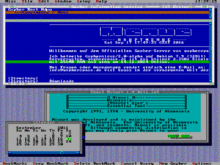Minnesota Internet Users Essential Tool

Minnesota Internet Users Essential Tool (Minuet) is an integrated Internet package for DOS Operating Systems on IBM-compatible PCs.
Background
Minuet was created at the University of Minnesota, in the early days of the World Wide Web (1994–1996). At that time, Internet software for the PC was immature — the only programs available were NCSA Telnet and NCSA FTP. Both were glitchy, hard to configure, and TTY-oriented.
The microcomputer support department at the university decided to come up with something better. Their design goals were:
- Runnable on any PC with at least 384 KiB of RAM, even an original 4.77 MHz PC.
- GUI interface
- Would run under DOS; not requiring Windows
- Easy to use
- Little or no configuration needed
- Multi-tasking
The result was "Minuet". Minuet was quite successful, being used at many colleges and institutions. Usage peaked around 1996, going down as Windows 95 and its free e-mail and web browser proliferated.
Implementation
The program was written in Turbo Pascal, using the Turbo Vision GUI. This base was a good match for the PCs of that time. Turbo Vision in its early incarnations used the 80×25 character text mode, meaning very speedy screen updates, even on slow PCs.
A homebrew multi-tasking kernel allowed users to have several Minuet windows active at the same time. An FTP session could be transferring files, while in another window, the user could be composing an e-mail. All the parts of Minuet used multi-tasking, the user did not have to wait for a slow operation to complete.
Functions
E-mail in Minuet resembles most standard e-mail programs — From:, To:, cc:, Bcc:, and Message body fields. Attachments use the BinHex and UUCP encoding schemes, which predated MIME and were popular in Minuet's days.
Newsgroups
Newsgroups appeared much like e-mail folders. An innovative concept was included — Minuet would not attempt to download the whole newsgroups file, which even then included thousands of newsgroups. Instead, a Perl server was contacted to search for interesting newsgroups. This cut down the newsgroup searching startup time from many minutes to a few seconds.
FTP
Minuet was one of the first programs to have a graphical tree-structured approach to FTP. At the time, most FTP clients required an almost endless sequence of "cd", "ls" commands to browse the server.
Web browser
In later releases, Minuet included a rudimentary Web browser, which was a challenge to implement on a 640 KiB real mode PC. If a graphics card was available, Minuet could display web pages containing GIF or JPEG images.
SLIP
At that time most PC users connected to the internet using a modem, so a robust modem-capable driver was required. Unfortunately, SLIP drivers of the time were poor — hard to configure, difficult to test, missing important features like dialing, and often not using all of the buffering features of the serial port chips. Consequently, the Minuet team developed a SLIP driver and dial-up program.
See also
References
- This article is based on material taken from the Free On-line Dictionary of Computing prior to 1 November 2008 and incorporated under the "relicensing" terms of the GFDL, version 1.3 or later.